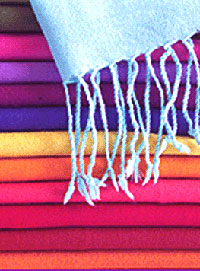Mauritius Textile Industry: What Future?

 |
| Textile Products on Display |
Segment 1 includes large vertically integrated operations 100% on Export: this segment is made up of 10 groups who employ approximately 35,000 people (63%) of which 6,000 people in “Textile” operations (very capital intensive) and 29,000 in garment making. Segment 2 is made up of about 400 entities, equally small operations which often subcontract capacity to the large operators; partly supply the ‘local’ market in clothing and partly export; buy their raw materials from the 10 large groups or import from overseas; and have limited marketing and financial resources.
Whilst both segments are important for the country, a large portion of segment 2 is reliant on segment 1for its raw materials and sub-contract work. In other words, the strength of segment 2 is partly dependant on segment 1. Enterprise Mauritius, today, caters mainly for the needs of segment 2. How is the industry performing today? The financial performance is very difficult over the past 12 months. Exports have dropped by 10% compared to last year for the first semester. In my opinion, 10% of companies are slightly profitable since January; 30% are at break-even; and 60% are making losses. The micro economics of the sector are therefore very difficult with a “freeze” in investments and some threats of bankruptcies or structural downsizing.
The external factors faced by the operators are the worst for many years and can be called “the perfect storm”. The key factors that have teamed up to provide this storm are the following:
1) The strength of the Mauritian Rupee: From 1st July 2007 to 30 June 2008, the Rupee appreciated by 15% against a “basket” of currencies against which operators export (Dollar, Pound Sterling, South African Rand, Euro). When an operator used to receive Rs 100 for a T-Shirt, he now gets Rs 85 for the same “currency” price to his customer. The Mauritian Rupee has also appreciated by 15% versus the Indian Rupee and the Bangladeshi currency (our competitor countries) over the first nine months of 2008.
2) Average increase of 15% in “input costs” driven mainly by energy, transport, salaries and wages: however, this is also true for our overseas competitors.
3) A very soft market in Europe, South Africa and USA due to slow or no economic growth in these countries, coupled with a loss of purchasing power. For this reason, there is an oversupply due to poor demand and increasing prices to customers. This perfect storm is likely to last 18 to 24 months until such time as our export markets start pulling again. In the meantime, the industry worldwide will shrink and once the markets pick up again, prices will increase again.
The textile industry needs affirmative actions Although Mauritius, today, is among the highest 20% in the world in terms of cost, it is cost competitive against the following countries where the textile sector still exists, namely Italy, Spain, Portugal, Greece, Turkey and Eastern Europe. Most of the operators which remain in Mauritius are locally owned and are in a fighting mood to face up the challenges. Hence, there is a future for the Mauritian textile industry.
The Indian and Chinese economies, the two textile powerhouses, are growing at 8% to 10% annually, which should lead to some inflation and strengthening of their currencies versus the Dollar and the Euro (in theory). This should help increase our “relative” competitiveness.
Why does Mauritius need the textile sector in the foreseeable future? There is consensus that a 6% to 7% GDP growth is desirable to keep employment at required levels. This will be difficult, even impossible, to achieve if the textile sector shrinks by 10% annually.
The sale of properties under the Integrated Resorts Scheme represents Sales of Assets and is non-recurring in the long term. In the absence of a significant Textile sector, the dependence on “Tourism” as the only major source of recurring foreign currency is risky. We need diverse recurring foreign currency sectors.
Finally, the industry employs very large numbers of unskilled people who do not have short term alternatives. Any sharp and drastic drop in the size of the textile industry could have very negative short and long term effects. What are the solutions? Both the operators and the authorities need to take affirmative actions to help the industry through this storm:
1) need to invest in marketing and product development to move upmarket, 2) need to invest in Lean Manufacturing and reduce waste at all levels, 3) need to regionalise and internationalise. 70% of the solution is in the operators’ hands.
On the authorities’ side, an uncompetitive currency versus our major competitors can simply kill off the industry. An appropriate monetary policy is required to keep a competitive currency. China and India have adopted affirmative actions like cheap finance, competitive energy and utility rates, and duty drawbacks.
It is important to acknowledge the fact that we are facing a perfect storm. Once this is done, we need to agree that we need this industry for the foreseeable future. Finally, all actors must sit around the table and let common sense prevail in terms of actions to be taken.
By Harold Mayer,
Chief Executive Officer of Ciel Textile.
(First published in Conjoncture, a Bilingual Journal of PluriConseil)
